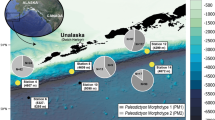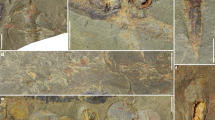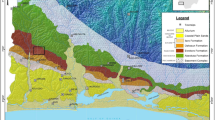Abstract
ALTHOUGH the calcareous nannoplankton have been the subject of considerable research during the past two decades, the factors which influenced the distribution of the fossil representatives of this group have been rather neglected. Several authors, however, allude to features of morphology, for example, thickening within species of Discoaster1–4 or the distribution of families or species of the calcareous nannoplankton which they attribute to the influence or in some instances lack of influence of ecological factors2,3,5.
This is a preview of subscription content, access via your institution
Access options
Subscribe to this journal
Receive 51 print issues and online access
$199.00 per year
only $3.90 per issue
Buy this article
- Purchase on Springer Link
- Instant access to full article PDF
Prices may be subject to local taxes which are calculated during checkout
Similar content being viewed by others
References
Bramlette, M. N., and Riedel, W. R., J. Paleontol., 28, 385 (1954).
Bramlette, M. N., and Sullivan, F. R., Micropaleontology, 7, 129 (1961).
Martini, E., in Submarine Geology and Geophysics, 393 (Butterworth, London, 1965).
Ramsay, A. T. S., in Scanning Electron Microscopy: Systematic and Evolutionary Applications, 179 (Academic Press, New York, 1971).
Worsley, T., and Martini, E., Nature, 225, 1242 (1970).
McIntyre, A., and McIntyre, R., in The Micropalaeontology of Oceans (Cambridge University Press, in the press).
Cann, J. R., and Funnell, B. M., Nature, 213, 661 (1967).
Ramsay, A. T. S., Marine Geol., 9, 261 (1970).
McIntyre, A., and Be, A. W. H., Deep Sea Res., 561, (1967).
Berger, W. H., Science, 156, 383 (1967).
Berger, W. H., Deep Sea Res., 15, 31 (1968).
Berger, W. H., Marine Geol., 8, 111 (1970).
Berger, W. H., and Parker, F. L., Science, 168, 1345 (1970).
Menard, H. W., Earth Planetary Sci. Lett., 6, 275 (1969).
Vogt, P. R., and Ostenso, N. A., Nature, 215, 810 (1967).
Menard, H. W., Science, 157, 923 (1967).
Laughton, A. S., et al., Summary of Deep Sea Drilling Project Leg XII, (1970).
Talwani, M., Pitman, W., and Heirtzler, J. R., Trans. Amer. Geophys. Union., 50, 189 (1969).
Funnell, B. M., and Smith, A. G., Nature, 219, 1238 (1968).
Berggren, W. A., Nature, 224, 1072 (1970).
Francheteau, J., thesis, Univ. California (1970).
Author information
Authors and Affiliations
Rights and permissions
About this article
Cite this article
RAMSAY, A. Aspects of the Distribution of Fossil Species of Calcareous Nannoplankton in North Atlantic and Caribbean Sediments. Nature 236, 67–70 (1972). https://doi.org/10.1038/236067a0
Received:
Revised:
Issue Date:
DOI: https://doi.org/10.1038/236067a0
This article is cited by
Comments
By submitting a comment you agree to abide by our Terms and Community Guidelines. If you find something abusive or that does not comply with our terms or guidelines please flag it as inappropriate.



